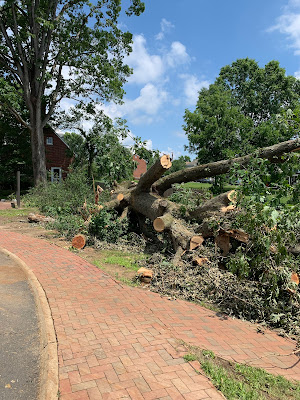On to Virginia where we had many items on our list of things to do. First stop was a very important one to me - the place of death of my 2x great grandfather, William J. Brooks.
We'd been here before but I really had no interest in history at that time and certainly had no idea that I had an ancestor who had fought and died here.
What a beautiful visitor center.
We headed down the sunken road.
This road was first called the County Road, then Telegraph Road, and it carried farmer's wagons and visitors into Fredericksburg. During the 1830's an adjacent landowner built stone walls along the road as it passed below Marye's Heights and Bromton, the home of John L. Mayre. In the 1862 battle, the road became known simply as the Sunken Road, one of the most famous byways in America.
This was where my 2x great grandfather, William J. Brooks, fought and died. His regiment, the 3rd South Carolina, came down Mayre's Heights across from the Innis House......
Bromton
Innis House
Bullet holes still show on the wall to the left of the window
....and then gathered behind the wall to defend against the Union attack.
So it was here, behind this wall, that my 2x great grandfather, William J. Brooks, and 162 of his fellow soldiers from the 3rd South Carolina, lost their lives on December 13, 1862.
We learned about the "Angel of Marye's Heights", Sergeant Richard Rowland Kirkland, Co, G, 2nd South Carolina Volunteers. Perhaps he and William Brooks knew each other.
The morning of December 14, 1862 brought a terrible vision of wounded Federal soldiers laying out in the battlefield after they had been wounded the day before. They had lain there all night on the frozen ground. The cries from the wounded were too much to bear for Sergeant Kirkland who made a request of CSA General Kershaw that he be allowed to bring water to the wounded on the battlefield. His request was denied.
Thankfully, the General relented and allowed Sergeant Kirkland to aid the wounded enemy soldiers. The Sergeant has gone down in history as the "Angel of Marye's Heights". Sergeant Kirkland went on to fight at Chancellorsville and Gettysburg, where he was promoted to lieutenant. Sadly, he was killed in action on September 20, 1863 at the Battle of Chickamauga.
Chain saws got a lot of work
Black Walnut trees are common - this one took a beating. We learned later that the insides of black walnuts are "inky" and can stain your hands. (no, we didn't learn from experience)
Years ago I connected with a descendant of William Brooks' wife (she was widowed with four small children when William was killed) and her second husband so we were "half" cousins. Sadly, she has since passed away but she left me with a powerful story. Either before his death or as he was dying, William gave his pocket watch to John Hayward Anderson and asked him to deliver it to his wife, Sarah. John and Sarah fell in love, married in 1868, had four children, and moved to Fresno in about 1888 where they lived until their deaths.
RIP, William J. Brooks.
William J. Brooks, 1835-1862
Dials Cemetery
Gray Court, Laurens County, South Carolina














Terrific history! Did you get me another black walnut?
ReplyDeleteYes we did - we put it in the freezer for safekeeping.
DeleteBarry’s family put walnuts on the driveway for cars to drive over in order to soften and open the outer shell.
ReplyDeleteWe used to have a lot of walnut trees in our area growing up and I never heard of putting them on the driveway. :-)
DeleteAmazing story to not only know when but exactly where your 2X great grandfather died. Such a special connection.
ReplyDeleteWhile I'd been there before, I had no idea of the meaning it had. But this time......
Delete